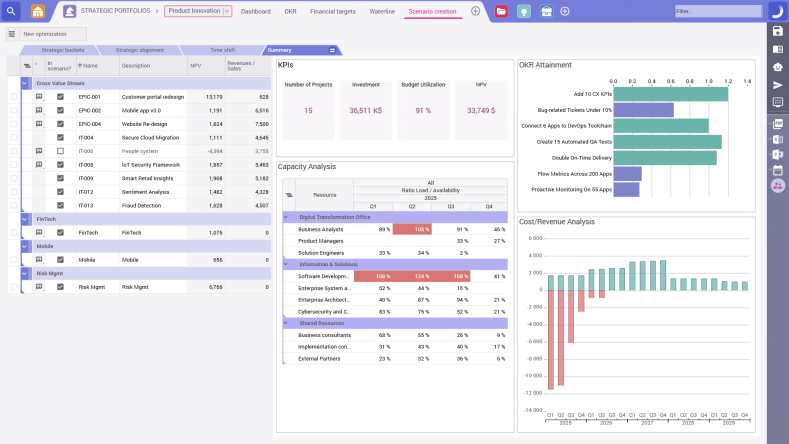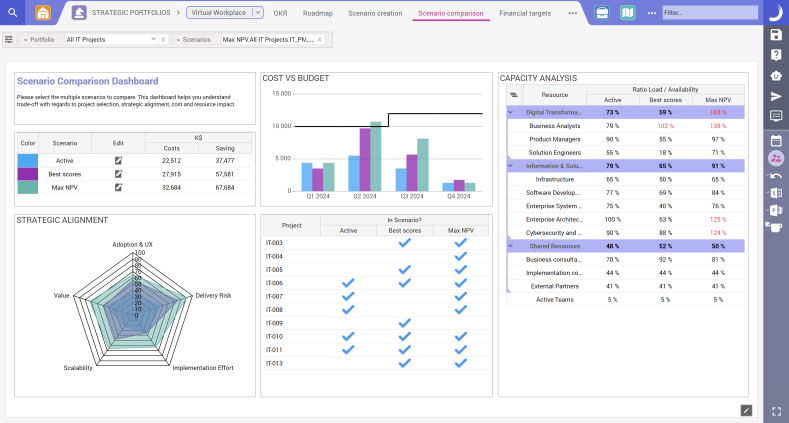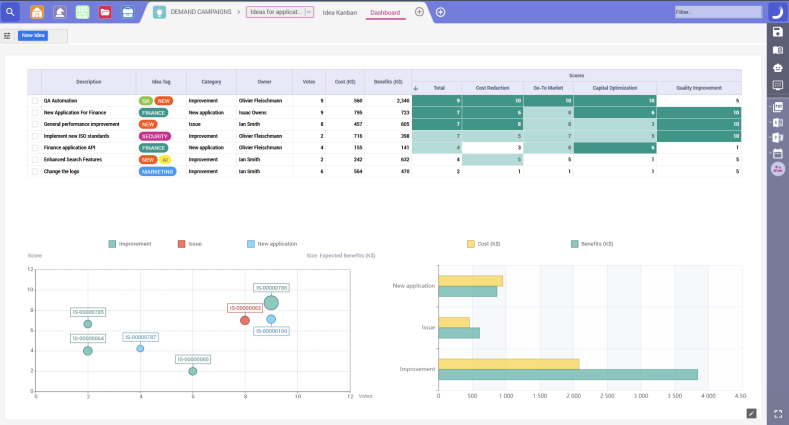What is a project portfolio?
A project portfolio is a set of project proposals, projects, programs, sub-portfolios, and operations managed together to achieve an organization's strategic objectives.
For instance, a company in the energy sector might have a business objective to reduce carbon emissions. The corresponding project portfolio would only include projects aligned with this objective. It could consist of sub-portfolios such as Improving the Efficiency of Solar Energy Production or Streamlining Transport Routes.
Defining project portfolios allows project-rich organizations to gain an overall perspective on their current and future projects. It also enables them to prioritize allocating investment and resources to projects most likely to help them achieve their strategic objectives.
A project portfolio might be grouped around:
- Geographical location of the projects
- Specific business objectives
- Specific capabilities (IT, HR, engineering, manufacturing)
- Target audience (employees, customer segments, suppliers)
It is necessary for most large enterprises due to the volume of projects running simultaneously. Take PepsiCo, for example, and their several-thousand-strong project innovation agenda.
But project portfolios can also benefit medium-sized organizations with ambitious growth objectives. For example, a domestic energy sector challenger may have an objective to grow their market share. The organization might set up a project portfolio that aligns with this goal, including “optimizing the digital customer journey” and “creating a referral program.”
A project portfolio has a number of key functions:
- Project prioritization: Evaluating, analyzing, and selecting projects based on a wide range of criteria, including ROI, risk, resources, and alignment.
- Resource management: Assigning and allocating money, time, and human resources within the portfolio in the most optimal way to drive value.
- Performance tracking: Monitoring KPIs and reporting as projects progress, informing ongoing decisionmaking.
- Risk management: Identifying risks that may negatively impact multiple projects or the organization’s strategic aims.
- Strategic alignment: Ensuring all projects within a portfolio are geared towards wider, long-term objectives.
What is the difference between a project and a project portfolio?
In simple terms, a project is a single series of tasks carried out over a predefined timeline with a clear, intentional goal (or goals). Projects within organizations can be limited to one team or department, but they usually require skillsets from multiple teams to complete.
A project portfolio, on the other hand, is a group of projects selected for their strategic value to an organization. The projects will have a clear link that connects them and will be managed together to maximize their efficiency and ROI.
Project portfolio management
The responsibility of managing the project portfolios—project portfolio management (PPM)—typically lies with the project management office (PMO). PPM refers to the ongoing processes involved in analyzing, prioritizing, and overseeing these projects to ensure maximum value of a project portfolio—that is, ensuring strategic alignment, optimized resource allocation, and effective risk management.
The PPM technology stack often centers around a powerful project and portfolio management tool that can provide visibility and access to all key stakeholders.
Creating and managing a project portfolio
Managing a project portfolio involves several processes:
- Identification: Identifying all potential projects and gathering data on objectives and outcomes.
- Evaluation: Analyzing each project based on criteria, such as strategic alignment.
- Prioritization: Determining the order in which projects happen.
- Resource management: Allocating budget, human resources, and equipment to each project in the portfolio.
- Ongoing monitoring: Tracking and reporting on progress of each project, with regular reviews to ensure strategic alignment.
Prioritizing your project portfolio
A project portfolio should always be prioritized based on an organization’s strategic objectives. Think of it like buying property in Monopoly. If your strategic objective is earning the most money before the game ends, you will want to prioritize locations with higher rent.
Questions that can help prioritize a project portfolio include:
- If this project is delivered successfully, what is its minimum impact on KPIs?
- Do competitors’ projects threaten the organization’s strategic objectives?
- How much risk is associated with the project, and what is the current tolerance for risk?
- Are enough resources available to deliver the maximum value of the project?
The process of deciding which projects are included in a project portfolio may involve these steps:
- Understanding the overall business objectives.
- Defining the role of this project portfolio, aligned with business objectives.
- Creating a set of inclusion criteria for the project portfolio. If you develop a project portfolio for new product innovation, you would only have projects with new products as an outcome.
- Speaking to project managers (PMs) and stakeholders (such as department heads, finance teams, or executive leadership) to source current projects and ideas.
- Analyzing the strategic value of relevant projects and comparing the results to inclusion criteria.
How many projects are in a project portfolio?
There is no magic number of projects to include in a project portfolio. The size of a project portfolio will depend on several factors that are unique to every organization:
- How many resources do you have? Successful project portfolios require excellent management, and individual projects need teams to deliver them. Resource requirements need to be scoped and agreed upon upfront with department or business unit leaders.
- How much risk can your organization take on? The more projects in a portfolio, the higher the potential for risks. Scheduling, dependencies, and communication are just some risks that need to be analyzed before adding more projects to a portfolio.
- What are the current business priorities? Not all projects contribute equally to an organization’s strategic goals. Before projects are added to a project portfolio, they need a strong business case, including predicted outcomes and associated costs.
- What are your project management capabilities? Has your organization already adopted a Project Portfolio Management mindset? If you are in the early stages of securing buy-in for project management transformation or building the capabilities of your PMO, consider how ready your PMs are to transition to this new approach.
Project portfolio templates, formats, and samples
PPM software solutions provide a suite of tools and templates that simplify and accelerate the entire process of managing a project portfolio, from project prioritization to resource allocation and risk management.
For example, scenario comparison and optimization features help you to streamline prioritization decision-making by creating comparisons between varying, complex projects using quantitative data from previous projects.


Scenario comparison using Planisware
These solutions also centralize your data and create a single source of truth. Intuitive dashboards give real-time visibility, providing PMOs with a range of information which empowers them to make the correct strategic calls about the project portfolio.
What is a project portfolio matrix?
A project portfolio matrix is a visual framework used by PMs or PMOs. It can be used to map out the potential value of projects compared to the technical complexity (and, therefore, level of investment) required to complete them. A project portfolio matrix can also be an effective way to visually communicate the status of projects within a portfolio to executive stakeholders.

Project portfolio examples
A few simplified examples illustrate how project portfolios exist across all settings and industries.
- Consumer goods: A snack foods manufacturer may have the objective to improve packaging sustainability and create a project portfolio along these lines—an example of a sub-portfolio may be Replace Single-use Plastics in Product Lines. Within this sub-portfolio, there may be a project called Develop Biodegradable Materials for Protein Bar Wrappers.
- Education: A school wanting to enhance student engagement through technology may create a project portfolio for this objective. Sub-portfolios may be called Introduce Interactive E-learning Platforms. A project may include Invest in Game-based E-learning Math Platforms.
- Financial services: A consumer bank with the aim to enhance digital banking capabilities may create a project portfolio aligned with this goal, with a sub-portfolio such as Improve Mobile App Functionality. A specific project within this sub-portfolio could include Add Budgeting Feature.
- Government: A government department aiming to improve green public transportation infrastructure may have sub-portfolios like Introduce Electric Bus Fleets. A project within this may be called Pilot Electric Bus Program in City Hub.
- Hospitality: A hotel wanting to encourage repeat bookings may have a sub-portfolio such as Use AI to Improve Guest Experience—a more specific project being Roll Out AI Food Recommendation Feature.
- Oil and gas: Within a project portfolio supporting an objective to transition to renewable energy sources, sub-portfolios might include Expanding Offshore Wind Capacity. An example of a project within this sub-portfolio could be Construct a Fifty MW Offshore Wind Farm.
- Pharmaceutical: A manufacturer aiming to boost drug development may have a sub-portfolio called Establish Partnerships with New Biotech Organizations, with a more specific project example being Partner with Canadian Gene Therapy Startup.
As a project-rich organization serving over 200 countries, PepsiCo is a standout real-world example of project portfolios in action. Their approach is to “think globally, act locally”—they strategically segment their $86 billion global portfolio around different need states, demand spaces, and consumer cohorts to drive innovation.
Ford is another example of an organization with a global portfolio of technology development projects, spanning electric vehicles, advanced safety technologies, and autonomous driving research.
If you’re ready to unlock strategic value for your organization through PPM, Planisware is the key.
Trusted by over 800,000 global users at organizations of all sizes and industries, our leading PPM software solutions can transform how you plan your project portfolios.
Book a demo with one of our experts today and start your organization’s journey toward streamlined project portfolio management.